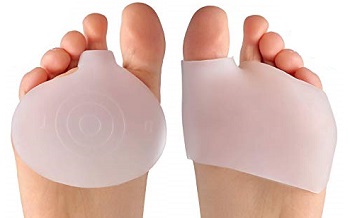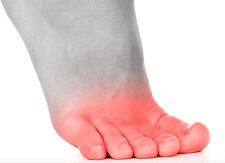- Home
- Common Foot Problems
- Mortons Neuroma
Mortons Neuroma
Written By: Chloe Wilson BSc(Hons) Physiotherapy
Reviewed By: FPE Medical Review Board
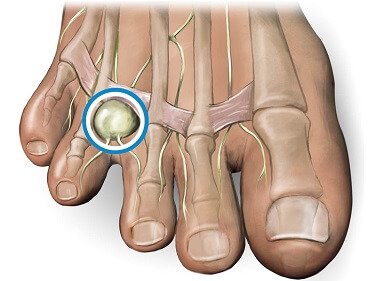
Mortons Neuroma is a condition where there is damage and swelling of the nerves that run between the toes.
It is characterized by a sharp, burning pain, tingling and numbness that can radiate from the ball of the foot into the toes. It usually occurs due to ongoing compression or irritation of the nerve and can make walking difficult.
Many people find walking and running uncomfortable with a Mortons neuroma and complain that it feels like there is a small stone underneath their foot.
Morton's neuroma is often associated with other foot problems such as bunions, hammertoe and flat feet or wearing tight or high-heeled shoes.
Treatment consists of rest, painkillers, injections, orthotics (shoe insoles) and occasionally surgery.
What Is A Mortons Neuroma?
A Mortons neuroma is a benign growth or thickening in the tissue surrounding the nerve, which irritates and compresses the nerve.
Morton's neuroma foot typically develops in response to excessive pressure, friction, irritation or an injury to one of the foot nerves as it travels to the toes.
The nerve may become squashed, trapped, ischaemic (meaning there is a reduced flow of blood to the nerve), or stretched. In response, there is swelling and inflammation of the nerve and a lump, known as a neuroma, may grow around the nerve. Morton's neuroma is one of the most common causes of ball of foot pain and foot pain when walking.
What Causes Morton's Neuroma
There are a number of things that increase the risk of developing mortons neuroma:
- Sports: Sports that place high-impact on the balls of the feet, such as running or climbing may damage the nerves
- Foot Deformities: Any alterations to the normal shape of the foot such as flat foot arches, bunions or hammertoes can change the way the pressure goes through the feet and irritate the nerves at the base of the toes
- Footwear: Wearing tight-fitting shoes, or high heels places increased pressure on the ball of the foot which can irritate the nerves leading to a mortons neuroma
- Gender: Mortons neuroma is thought to be 4-15 times more common in women than men. This is thought to be due to footwear
- Age: Mortons neuroma typically affects people between the ages of 40-60
Mortons Neuroma Symptoms
The most common symptoms of mortons neuroma foot are:
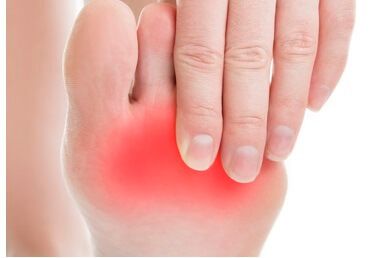
- Pain in the Ball of the Foot: It may be a sharp, stabbing, shooting or burning pain and may spread into the toes
- Tingling and Numbness: There may be a feeling of pins and needles or decreased sensation in the ball of the foot and into the toes
- Pebble Like Feeling: People with mortons neuroma often comment that when they are walking it feels like there is a small stone in their shoe, or that their sock has creased up underneath them
The symptoms of mortons neuroma foot are usually felt between the 3rd and 4th toes, sometimes between the 2nd & 3rd toes and only occasionally between the 1st & 2nd or 4th & 5th toes. There are lots of other possible causes of a lump on bottom of foot.
How To Treat A Mortons Neuroma
Mortons neuroma foot pain symptoms are unlikely to settle without appropriate treatment which typically involves a combination of:
- Appropriate Footwear: Opt for flat shoes with thick cushioned soles and a wide toe box
- Metatarsal Pads: Simple inserts for your shoes that reduce the pressure on the nerves. There are a wide variety of metatarsal pads to choose from
- NSAIDs: Non-steroidal anti-inflammatory drugs such as ibuprofen and naproxen can help to reduce the pain and swelling associated with mortons neuroma - always check with your doctor before taking any medication
- Ice Massage: Using ice regularly for 10-15 minutes at a time can also help to reduce the pain and nerve damage. Either use an ice pack on the ball of your foot, or massage the area with an ice cube. You can find out more about how to use ice effectively and safely in the ice treatment section
- Steroid Injections: Your doctor may recommend a corticosteroid injection which helps to reduce the pain and inflammation in the nerve
- Avoid High-Impact Activities: Try to limit activities that place a lot of pressure through your feet such as jogging. Instead opt for low impact activities such as swimming
- Weight Loss: If you are overweight, then losing weight will place less pressure through your feet
Mortons Neuroma Surgery
If the symptoms of mortons neuroma have not settled after three months of treatment, then your doctor may advise surgery. There are a couple of options when it comes to mortons neuroma surgery:
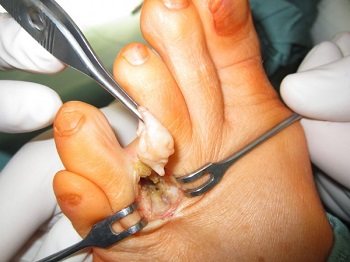
- Nerve Decompression: Pressure on the nerve is relieved by dividing (cutting) nearby structures such as the deep transverse ligament that joins the adjacent foot bones
- Neurectomy: This is where the growth in the nerve, the neuroma, is removed. Whilst usually very successful, there is a risk of long term numbness in the surrounding area
Recovery Process
It can take anything from a few weeks to several months to recover from morton's neuroma, depending on the severity and type of treatment. Generally, the earlier you start treatment, the quicker you will recover as over time, the lump is likely to grow and cause more problems.
Recovery time from Morton's neuroma surgery can vary, depending on the type of surgery. Other factors, such as age, overall health, and lifestyle choices can also play a role. Most people are able to return to regular activities within 4-6 weeks following mortons neuroma surgery, although it can take longer to achieve full recovery.
Your Questions Answered
Do Neuromas Go Away On Their Own? A Morton's neuroma will not go away on it's own, however the symptoms will often come and go depending on what you are doing and what shoes you wear. Left untreated, a Mortons Neuroma is permanent.
How Do You Treat A Neuroma? To treat a Morton's neuroma you want to reduce the inflammation using ice, NSAID's and steroid injections, and take the pressure off the foot by wearing wide, comfortable shoes, using metatarsal pads in your shoes and avoiding high impact activities such as jumping and running.
What Does A Neuroma Feel Like? People often describe a Mortons neuroma as feeling like there is a small stone in your shoe. There is usually burning, stabbing pain underneath the foot and sometimes tingling and numbness.
What Happens If Mortons Neuroma Goes Untreated? If left untreated, the symptoms of a Morton's Neuroma typically get worse and worse. Pain increases, which gradually limits daily activities. People often change how they walk to try and keep the pressure off their Mortons neuroma but this can lead to back, hip and knee pain.
Can A Mortons Neuroma Be Cured? Yes! The most important thing is to diagnose the underlying cause of the neuroma and address that. Most cases of morton's neuroma will settle down with simple home treatments, but persistent cases may require surgery.
Can You Walk After Mortons Neuroma Surgery? Yes - you will be given a special walking shoe to use for the first 2-4 weeks to protect the foot. Walking should be kept to a minimum the first few weeks and the foot should be kept elevated to help reduce swelling. It usually takes 4-6 weeks for the swelling to go down enough for you to wear your normal shoes.
How Successful Is Mortons Neuroma Surgery? Typically, surgery for Morton's neuroma is extremely successful but some studies have shown that around 20-30% of people undergoing surgery are dissatisfied with the results. The most common reasons for this are that the neuroma was misdiagnosed in the first place, incorrect surgical technique or complications such as ongoing swelling and pain.
Can A Mortons Neuroma Grow Back After Surgery? Whilst surgery for mortons neuroma is usually successful, in up to 30% of cases there is a reccurence. Either the neuroma regrows or a stump neuroma forms. Around 10% of people undergo repeat surgery for a Mortons Neuroma.
Does Ice Help Mortons Neuroma? Ice massage over a Mortons neuroma can really help to reduce pain and inflammation. Gently run an ice cube over the foot, keeping it moving, or rest with an ice pack on the area for 10-15 minutes at a time. N.B. If you have any problems with circulation or sensation in your foot, you should not use Ice Therapy.
Does Mortons Neuroma Show Up On X-ray? A Morton's neuroma will not show up on an x-ray as x-rays show bone not soft tissue. However x-rays can be helpful for ruling out other conditions such as arthritis when diagnosing Mortons Neuroma
What Else Can Help?
Mortons neuroma is just one of the possible causes of tingling and numbness in the feet. There are a number of other conditions that can affect the nerves of the foot and produce similar symptoms. You can find out more in the foot nerve pain section.
There are also lots of other things that can cause a lump underneath the foot - check out the bump on bottom of foot article for common causes, symptoms, diagnosis and treatment options.
If your only symptom is toe pain, then again, there may be something different going on. Visit the toe joint pain section to find out what else could be wrong if the information here on mortons neuroma isn't sound quite like your pain.
You may also be interested in the following articles:
- Ball Of Foot Pain
- Pain On Top Of Foot
- Foot Arch Pain
- Burning Foot Pain
- Foot & Ankle Stretches
- Foot Numbness
- Foot Lumps & Bumps
- Foot Pain When Walking
Related Articles
References
1. "Mortons Neuroma" CKS NICE: Clinical Knowledge Summaries from the National Institute for Clinical Excellence
2. NHS UK: Mortons Neuroma. November 2018
Page Last Updated: 3rd October, 2024
Next Review Due: 3rd October, 2026
